|
|
||
|
Its very rare that one can say they walked in a railroad tunnel let alone multiple ones like we did. Its very amazing how during the day one place can look peaceful but at night that changes. I found these tunnels to be very haunted its a pretty eerie place to be once you start hiking further into the trail. I will also be posting photos of Hoover Dam which I took. The trail will take you to the dam after you enter multiple tunnels cut right into the mountain along a ridge. Along the ridge is quite a drop to the bottom its extremely even scenic at night. The history goes as this that an old railroad bed was built in the 1930s and five tunnels had to be carved into the mountain. This railroad would haul materials and equipment used in the construction of Hoover Dam. The trains would run 24 hours a day and in 1961-1962 the tracks were dismantled. The first tunnel is over a mile from the trailhead its quite the hike. The views of Boulder Basin are amazing even at night the dim lights on the water below is breathtaking. If you want deeper history into this in 1931 Lewis Construction Company began the construction in this area. In 1984 this made the National Register Of Historic Places technically some of the tunnels did receive some restoration work. The length of the trail is almost 3 miles we did hike just about the full length and back. All the tunnels are around 300 feet in length and 25 feet in diameter. The tunnels were made very large to fit the penstock sections and large equipment being transported to the dam. This line had nine steam and four gas locomotives along with 71 railway workers operating this project. Its said that some of the rail system is underwater behind the tunnels. A section of these tunnels appeared in the motion picture called "The Gauntlet" with Clint Eastwood and Sondra Looks which they were on a motorcycle being chased by an assassin in a helicopter. If you want more history in detail you can read further below along with the history of Hoover Dam. This was a very good investigation in my opinion it might be one of the best so far we ever did in Vegas. The activity is very high inside and outside the tunnels. Not only was it a great exploration but also a great paranormal investigation! Alot of people and I mean ALOT lost their lives in this area during the dams construction. It was not a pretty site men would go to work only to never see their families again. It is very history and significant to the Hoover Dam area. Also along the trail is Lake Mead a man made lake which has been known for its giant catfish, dumping of garbage and dead bodies found. © By Lord Rick
Daytime Tunnel/RailBed A journey begins! The Long Road Ahead Tunnels A Journey Ends! Hoover Dam Photos Below
From
Below : http://hikearizona.com/decoder.php?ZTN=423
for
scholastic use only!
Construction History of Hoover DamA Brief Overview of Hoover Dam Construction
Awarding of the Hoover Dam Contract. Six construction firms created a consortium call Six Company, Inc. to submit a competitive proposal to build Hoover Dam. As the lowest qualified bidder at $48,890,955, Six Company was awarded the contract. It was given incentive bonuses and would be fined for each day construction overran the assigned schedule. Thus began a furious pace of around the clock construction, which would result in completion of Hoover Dam almost two years ahead of schedule.
Hoover Dam required over 3,250,000 cubic yards of concrete plus another million for the power plant, intake towers and other support structures. Two batch plants onsite were created to produce the concrete that was transported on railcars in large four and eight cubic yard buckets. An overhead cableway system lifted the buckets and lowered them to the forms. At peak production, one bucket was delivered about every 78 seconds. See more information and statistics on our Hoover Dam home web page.
It is interesting to note that it would have taken about 100 years for the concrete to cool and properly cure without engineering intervention. The chemical heat generated by concrete setting was dissipated by imbedding over 582 miles of one-inch steel pipe through the interconnecting concrete blocks that circulated ice water. Its own ammonia refrigeration plant that cooled the water was capable of creating a gigantic 1000 pound ice block every day.
It was the job of High Scalers to hang dangerously by rope above the canyon to blast and remove weakened and loose rocks from the face of the Black Canyon cliffs where the ends of Hoover Dam would join. Read more about these High Scalers that risked their lives not only performing their jobs, but also entertaining workers below with thrill-seeking and death-defying stunts along the cliff walls.
Welcome to Lake Mead
Lake Mead was created by the building of Hoover Dam which has a storied history of sacrifices made by the men, women and families that were involved with the dam's construction. Read more about Hoover Dam which at one time was called Boulder Dam is located on the northwest border of Arizona and southeast Nevada.
Lake Mead is the second largest man-made reservoir lake in the United States behind Lake Powell on Arizona's northern border. Lake Mead extends over 110 miles from the dam to the western edges of the Grand Canyon. The lake stores over 28.5 million acre-feet of water fed by the Colorado River. The lake extends into both Arizona and Nevada and holds 9.2 trillion gallons of water which is the equivalent of two-years of flow through the Colorado River. The lake features over 550 miles of shoreline and varies in depth. Where Ancient Peoples Once Roamed.Ten thousand years before the dam was built in 1935, the area along the river was home to ancient Native American cultures whose artifacts, pottery and hunting implements continue to be discovered today. Evidence indicates prehistoric peoples hunted game and practiced farming. In a cave near the present day Lake Mead, archaeologists have discovered remains of ancient animals with notches on the bones giving evidence of preparation and consumption by humans thousands of years previous. Fishing At Lake Mead.Anglers will find Striped Bass, Largemouth Bass, Crappie and Catfish throughout the lake. Both Arizona and Nevada require a state fishing license for those 14 years or older when fishing portions of the lake located within each particular state. A "use stamp" issued in either state will permit fishing in either state's Lake Mead waters. Lake Mead Recreation.The Lake Mead National Recreation Area also includes Lake Mohave, south of Lake Mead along the Colorado River. Combined, the area is larger than the state of Rhode Island. Lake Mead by itself is a massive water recreation playground that entices millions of annual visitors to its startling blue waters. The picturesque landscape is a mixture of desert outcroppings, lushly vegetated banks and high canyon walls that draws scenic photographers to its visual charm.
|
||
|
|
||
|
society, Mib, conspiracy, time travel, specters, Armageddon, prophets, prophecy, paranormal, ghosts, aliens, Buffalo, haunted houses, cryptozoology, dimensions, apocalypse, Atlantis, curses, monsters, wildman, yeti, cemetery, stigmata, vampyre, vampires, angels, bizarre, metaphysics, Atlanta, Louisiana, Myrtle Beach, planet x, mothman, jersey devil, apparitions, werewolf, werewolves, devils, vortexes, Bermuda triangle, lycanthropes, mystery, ancient, spirits, cydona, mythology, Charlotte, Atlanta, Mobile, possession, possess, mailing list, parapsychology, poltergeist, evp, investigation, crop circles, Roswell, abduction, project blue book, living dinosaurs, religious miracles, ny, sightings, north Carolina, south, brown mountain, cleansing, shadowmen, beast, ogopogo, death, portals, spontaneous human combustion, zombies, ouija boards, nostradamus, Edgar Cayce, art bell, George Nooray, Magick, Paganism, Wicca, Tennessee, Halloween, bigfoot, Sasquatch, ufo, grays, ufos, vortexes, alien, hybrids, Haunting's, demons, demonology, occult, mystics, lochness, chupacabras, equipment, Thermal, EMF, Cassadaga, energy, asteroid, civil war, spooky, scary, adventure, ectoplasm, orbs, graveyards, demons, spirits, cults, buffalo, new York, ghost society, logo wear, equipment, books, videos, music, certification, Castles, Forts, fortean, phenomena, nonprofit, business, investigations, SPH, EMF, ghosthunting, organization, conventions, hollow earth, paranormal & ghost Society, detector, posters, mailboxes, donate, Buffalo, xfiles, Ectoplasm, magick, spells, wicca, paganism, holy, cross, NWO, Patriot, 911, September 11th, tours, cryptid, ghostlights, dinosaurs, Florida, Fl, Daytona Beach, Jacksonville, St. Augustine, Debary, Miami, Tampa bay, Sarasota, Pensacola, NASA, Cape Canaveral, Space Coast, space shuttle, gulf breeze, key west, Sanford, port orange, Ormond beach, New Smyrna, Orlando, Disney world, Tallahassee, Stetson university, panama city, Alabama, Georgia, Savannah, New Orleans, Cocoa Beach, Ocala, plantations, Fort Lauderdale, Melbourne, Naples, Lake Wales, grim reaper, everglades, Seminoles, big cats, Fort Myers, St. Petersburg, Lakeland, Gainesville, West Palm Beach, bike week, spring break, Deland, Deltona, Orange City, weird, strange, bizarre, mysterious, rituals, skunk ape, adventure, ships, ghost pirates, ball lightning, x-files, conspiracies, Las Vegas, California, Nevada, wild west, Mojave, Navajo, timucuans, Seneca's, Iroquois, Cult, Occult, Indians, Historical, Bands, Gothic, New Age, Spiritualism, Parapsychology, CA, California, youtube, media, hard rock, heavy metal, Portal, 666, demons, fallen angels, gods, CA, Reno, Las Vegas, Sacramento, San Francisco, Roseville, Woodland, Davis, Los Angeles, Oakland, San Jose, Lodi, Napa, Vallejo, San Andreas, Modesto, Tahoe, Santa Rosa, Redding, Yuba City, San Diego, Eureka, Chico, Fresno, Salinas, Stockton, Oxnard, Auburn, Fairfield, Vacaville, NV, Carson City, Nevada, Eldorado, Yosemite, Merced, Hollywood, Eugene, Oregon, Salem, Portland, Bend, Boise, Salt Lake City, Seattle, Washington, AZ, Phoenix, Native American Folklore, Beatty, NV, Sin City, Mines, Bakersfield, Fresno, Jackson, San Andreas, Sutter Creek, Folsom Lake, Citrus Heights, Redding, Sierra Nevada's, Foothills, Spaniards, Savannah, Kinzua, Hoover Dam, Henderson, 420, Marijuana, weed, pot, joint, science, caves, spelunking, stunts, extreme, desert, woods, swamps, caving, tunnels, catacombs, UE, Urban exploration, abandonment's, video, movies, production, new age, ambient, techno, Satanism, convention, conferences, thermal detector, digital recorder, d5, deggi5, abandoned, trespass, trespassing, death, druid, curse, cursed, Chumash,Hupa ,Mission, Nez Pace, Pajute, Pomo, Salish, Ute, Creek, Cherokee, Chickasaw, Pueblo, Hopi, Anasazi, Apache |
|








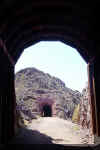
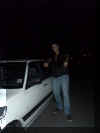


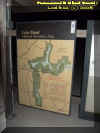

















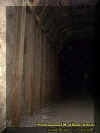
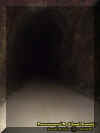

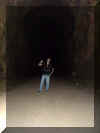
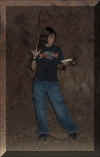
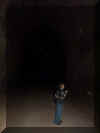
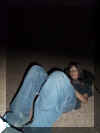
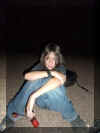










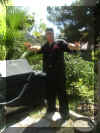














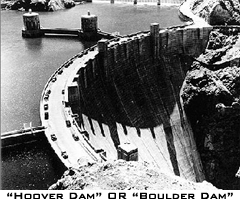 “Hoover Dam” or “Boulder Dam”.
Few know that Hoover Dam was originally named Boulder Dam. That’s
because the initial planned site was at Boulder Canyon about 10 miles
north upriver from where it is now located at Black Canyon. An engineering
reassessment moved the location from Boulder Canyon to its present
location. The Herbert Hoover administration changed the name from Boulder
Dam to Hoover Dam in 1930 as a political move. In 1933, the Franklin
Roosevelt administration changed it back to Boulder Dam, and under Harry
Truman, the permanent name of Hoover Dam was restored.
“Hoover Dam” or “Boulder Dam”.
Few know that Hoover Dam was originally named Boulder Dam. That’s
because the initial planned site was at Boulder Canyon about 10 miles
north upriver from where it is now located at Black Canyon. An engineering
reassessment moved the location from Boulder Canyon to its present
location. The Herbert Hoover administration changed the name from Boulder
Dam to Hoover Dam in 1930 as a political move. In 1933, the Franklin
Roosevelt administration changed it back to Boulder Dam, and under Harry
Truman, the permanent name of Hoover Dam was restored.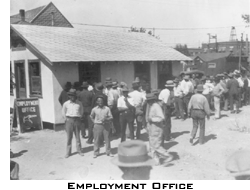 The Great Depression led to massive
migration of the unemployed to Las Vegas
in hopes of landing jobs building Hoover Dam. Men came from around the
country, many bringing families and life’s possessions hoping for
employment. Living conditions were difficult and became substantially much
worse when construction began, creating the shantytown known as Ragtown.
Read more about the
The Great Depression led to massive
migration of the unemployed to Las Vegas
in hopes of landing jobs building Hoover Dam. Men came from around the
country, many bringing families and life’s possessions hoping for
employment. Living conditions were difficult and became substantially much
worse when construction began, creating the shantytown known as Ragtown.
Read more about the 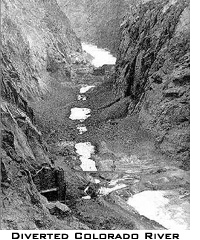 The Colorado River had to be diverted before construction could
begin. The riverbed had to be
dredged clear of deep silt and sediment to expose a bedrock foundation for
the building of Hoover Dam. It was a tedious process of digging four
diversion tunnels through canyon walls that would divert river flow around
the dam site to join the Colorado River farther downstream. Click here to
read more about the
The Colorado River had to be diverted before construction could
begin. The riverbed had to be
dredged clear of deep silt and sediment to expose a bedrock foundation for
the building of Hoover Dam. It was a tedious process of digging four
diversion tunnels through canyon walls that would divert river flow around
the dam site to join the Colorado River farther downstream. Click here to
read more about the 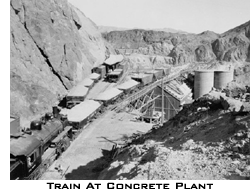 The base of Hoover Dam alone required 230 individual gigantic blocks of
concrete. Five-foot tall blocks of varying width, ranging from 25 square
feet on the downstream face to 60 square feet on the upstream face.
Columns were linked together like a giant Lego set with a system of
alternating vertical and horizontal schemes.
The base of Hoover Dam alone required 230 individual gigantic blocks of
concrete. Five-foot tall blocks of varying width, ranging from 25 square
feet on the downstream face to 60 square feet on the upstream face.
Columns were linked together like a giant Lego set with a system of
alternating vertical and horizontal schemes.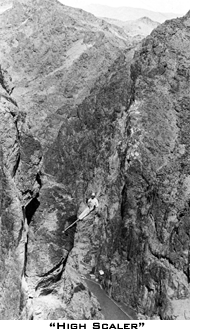 The cooling pipes were subsequently back-filled with concrete to create
added strength. As an arch-gravity dam, the massive water pressure of up
to 45,000 pounds per square foot at the base of Hoover Dam, is held back
by gravity. The arch-curved structure against the lake reservoir
dissipates that pressure into the canyon walls equally on the Arizona and
Nevada side.
The cooling pipes were subsequently back-filled with concrete to create
added strength. As an arch-gravity dam, the massive water pressure of up
to 45,000 pounds per square foot at the base of Hoover Dam, is held back
by gravity. The arch-curved structure against the lake reservoir
dissipates that pressure into the canyon walls equally on the Arizona and
Nevada side.

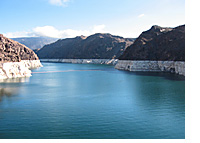 Lake
Mead is a vast lake of major proportions with several marinas and
campgrounds. It is a water-wonderland that caters to fisherman, house
boaters, jet-skiers, water-skiers, power boaters, swimmers, sunbathers and
those that love to see the sights. The lake features hiking trails of
various levels of difficulty and it's a great place to observe native
wildlife including Kit Fox, Bobcats, Ringtail Cats, Mule Deer, the rare
Bighorn Sheep and a variety of typical desert creatures including Gila
Monsters, Rattlesnakes and the mystifying Chuckawalla Lizards.
Lake
Mead is a vast lake of major proportions with several marinas and
campgrounds. It is a water-wonderland that caters to fisherman, house
boaters, jet-skiers, water-skiers, power boaters, swimmers, sunbathers and
those that love to see the sights. The lake features hiking trails of
various levels of difficulty and it's a great place to observe native
wildlife including Kit Fox, Bobcats, Ringtail Cats, Mule Deer, the rare
Bighorn Sheep and a variety of typical desert creatures including Gila
Monsters, Rattlesnakes and the mystifying Chuckawalla Lizards.